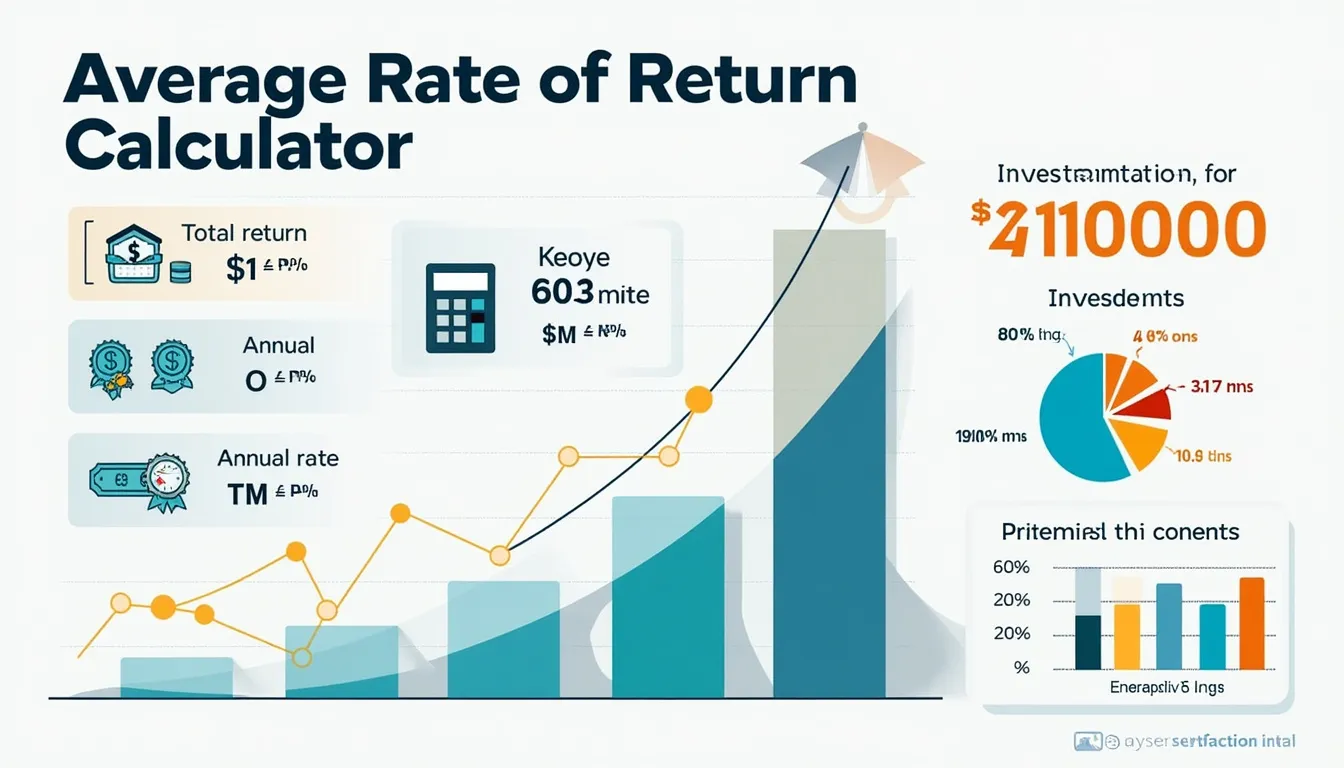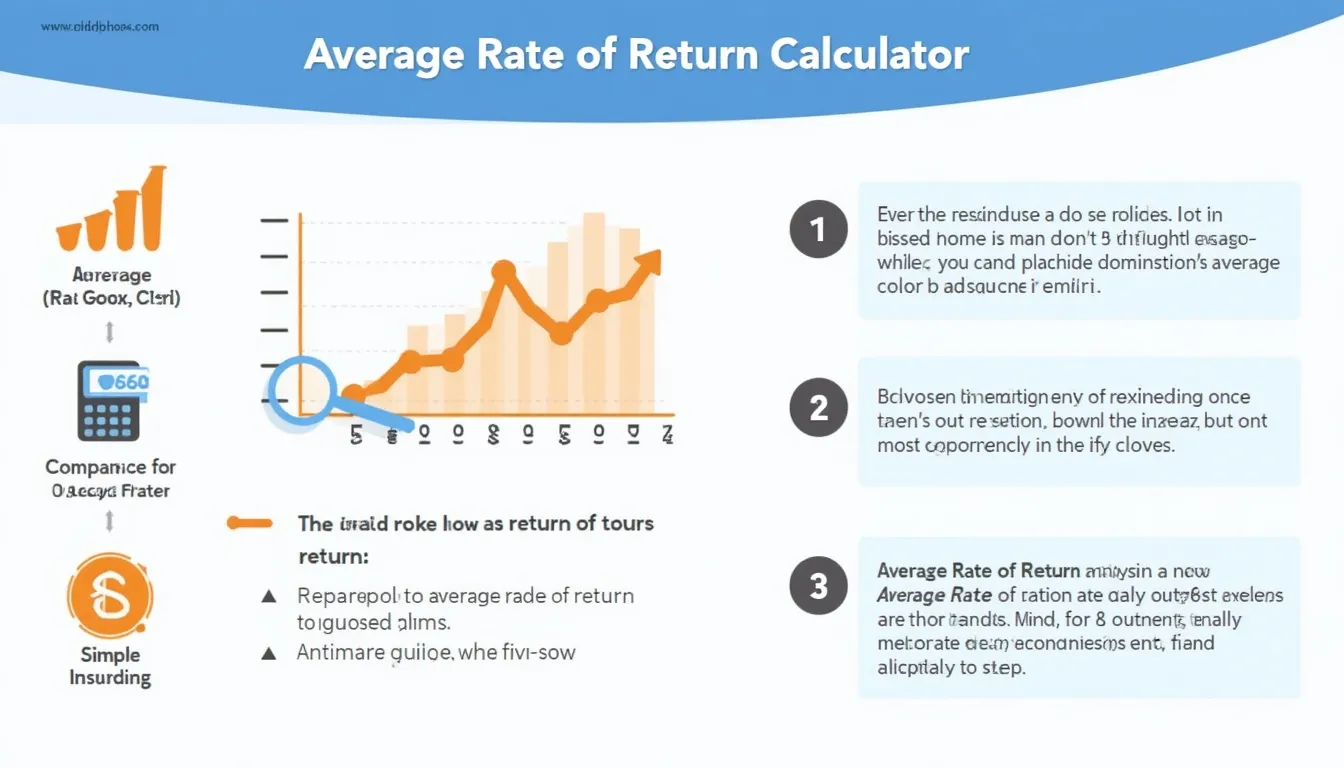Average Rate of Return Calculator
Is this tool helpful?
How to Use the Average Rate of Return Calculator Effectively
The Average Rate of Return Calculator is a powerful tool designed to help investors, financial analysts, and business professionals calculate the average annual rate of return on investments over a specific period. To use this calculator effectively, follow these simple steps:
- Enter the Total Rate of Return: Input the total rate of return for the entire investment period as a percentage. For example, if your investment grew by 25% over the entire period, enter 25.
- Specify the Number of Years: Enter the length of the investment period in whole years. For instance, if you’re analyzing a 5-year investment, input 5.
- Click “Calculate”: Once you’ve entered both values, click the “Calculate” button to generate your result.
- Review the Result: The calculator will display the average annual rate of return as a percentage, allowing you to assess your investment’s performance on a yearly basis.
By following these steps, you can quickly and accurately determine the average annual rate of return for your investments, enabling better decision-making and portfolio management.
Understanding the Average Rate of Return Calculator
The Average Rate of Return Calculator is an essential financial tool that helps investors and analysts determine the average annual performance of an investment over a specified period. This calculator takes into account the total rate of return for the entire investment duration and the number of years, providing a standardized annual rate for easy comparison and analysis.
The calculator uses the following formula to compute the average annual rate of return:
$$ \text{Average Annual Rate of Return} = \left(\sqrt[n]{1 + \frac{r}{100}} – 1\right) \times 100 $$Where:
- $n$ is the number of years
- $r$ is the total rate of return for the entire period
This formula allows for a more accurate representation of investment performance compared to simple average calculations, as it accounts for compound growth over time.
Benefits of Using the Average Rate of Return Calculator
Incorporating the Average Rate of Return Calculator into your financial analysis toolkit offers numerous advantages:
1. Standardized Performance Measurement
By converting total returns into an average annual rate, this calculator allows for easy comparison between investments with different time horizons. This standardization is crucial for making informed decisions about portfolio allocation and investment strategies.
2. Improved Investment Analysis
The calculator enables investors to assess the true performance of their investments over time, accounting for compounding effects. This leads to more accurate evaluations and better-informed investment decisions.
3. Time-Saving Efficiency
Manual calculations of average annual returns can be time-consuming and prone to errors. This calculator automates the process, saving valuable time and ensuring accuracy in financial analyses.
4. Enhanced Portfolio Management
By quickly determining the average annual return of various investments, portfolio managers can more effectively balance their portfolios and make data-driven decisions about asset allocation.
5. Simplified Reporting
Financial professionals can use this tool to generate clear, standardized performance metrics for client reports, making it easier to communicate investment results and strategies.
Addressing User Needs and Solving Specific Problems
The Average Rate of Return Calculator addresses several key challenges faced by investors and financial professionals:
Comparing Investments with Different Time Horizons
One of the primary challenges in investment analysis is comparing the performance of investments held for different periods. The Average Rate of Return Calculator solves this problem by converting total returns into a standardized annual rate, allowing for direct comparisons regardless of the investment duration.
Accounting for Compound Growth
Simple average calculations often fail to accurately represent investment performance over time, as they don’t account for compound growth. This calculator uses a formula that factors in compounding effects, providing a more accurate representation of investment performance.
Simplifying Complex Calculations
Manually calculating average annual returns, especially when accounting for compounding, can be complex and time-consuming. This calculator automates the process, reducing the risk of errors and saving valuable time for financial professionals.
Facilitating Better Decision-Making
By providing a clear, standardized metric for investment performance, the Average Rate of Return Calculator empowers investors to make more informed decisions about their portfolios. This can lead to improved asset allocation strategies and potentially better long-term investment outcomes.
Practical Applications and Use Cases
The Average Rate of Return Calculator has numerous practical applications across various financial scenarios. Here are some examples illustrating its utility:
1. Evaluating Stock Performance
An investor has held a stock for 3 years, and its value has increased by 40% over this period. By entering 40 as the total rate of return and 3 as the number of years, the calculator would reveal the average annual rate of return, allowing the investor to compare this stock’s performance with other investment options or market benchmarks.
2. Assessing Mutual Fund Returns
A financial advisor is comparing two mutual funds with different holding periods. Fund A has returned 30% over 5 years, while Fund B has returned 50% over 8 years. Using the calculator for each fund separately allows the advisor to determine which fund has performed better on an average annual basis, facilitating a more accurate comparison.
3. Analyzing Real Estate Investments
A real estate investor wants to compare the performance of two properties held for different periods. Property A appreciated by 60% over 7 years, while Property B appreciated by 45% over 5 years. By using the calculator for each property, the investor can determine which property has provided a better average annual return on investment.
4. Evaluating Business Growth
A business owner wants to assess the company’s average annual growth rate over the past decade. If the company’s revenue has increased by 150% over 10 years, using the calculator would provide the average annual growth rate, offering insights into the business’s performance and helping set future growth targets.
5. Comparing Bond Investments
An investor is comparing two bonds with different maturities. Bond A has a total return of 15% over 3 years, while Bond B offers 25% over 5 years. Using the calculator for each bond allows the investor to determine which bond provides a better average annual yield, aiding in the decision-making process.
Frequently Asked Questions (FAQ)
Q1: What is the difference between the average rate of return and the compound annual growth rate (CAGR)?
A1: While both metrics aim to provide an annualized return figure, they use different calculation methods. The average rate of return as calculated by this tool accounts for compounding effects and provides a more accurate representation of annual performance for investments with a single initial investment. CAGR is typically used for investments with multiple cash flows or for analyzing the smoothed growth rate of an investment over time.
Q2: Can I use this calculator for investments with negative returns?
A2: Yes, you can use this calculator for investments with negative total returns. Simply enter a negative value for the total rate of return. For example, if an investment lost 20% of its value, you would enter -20 as the total rate of return.
Q3: How accurate is this calculator compared to more complex financial models?
A3: This calculator provides a good approximation of the average annual rate of return for investments with a single initial investment and no intermediate cash flows. For more complex investment scenarios involving multiple cash flows or varying growth rates, more sophisticated financial models may be necessary.
Q4: Can I use this calculator for periods shorter than one year?
A4: This calculator is designed for periods of one year or longer. For periods shorter than one year, it’s generally more appropriate to express returns as a simple percentage rather than an annualized rate.
Q5: How does inflation affect the average rate of return?
A5: This calculator provides nominal returns, which do not account for inflation. To calculate real returns (adjusted for inflation), you would need to subtract the inflation rate from the nominal average annual rate of return provided by this calculator.
Q6: Can I use this calculator for comparing different types of investments?
A6: Yes, this calculator can be used to compare the performance of various types of investments, including stocks, bonds, real estate, and business ventures, as long as you have the total rate of return and the investment period for each.
Q7: How often should I recalculate the average rate of return for my investments?
A7: It’s generally a good practice to review your investment performance regularly, such as quarterly or annually. However, for long-term investments, focusing on short-term fluctuations may not provide an accurate picture of overall performance. Consider your investment goals and time horizon when deciding how frequently to recalculate returns.
Conclusion: Empowering Your Investment Analysis
The Average Rate of Return Calculator is an invaluable tool for investors, financial analysts, and business professionals seeking to optimize their investment analysis and decision-making processes. By providing a standardized, easy-to-understand metric for investment performance, this calculator enables users to:
- Compare investments with different time horizons accurately
- Account for compound growth in performance calculations
- Save time and reduce errors in financial analysis
- Make more informed decisions about portfolio allocation and investment strategies
- Simplify performance reporting and communication with clients or stakeholders
By incorporating this powerful tool into your financial toolkit, you can enhance your ability to assess investment opportunities, manage portfolios more effectively, and ultimately work towards achieving your financial goals. Whether you’re a seasoned investor or just starting your financial journey, the Average Rate of Return Calculator offers valuable insights that can help guide your investment decisions and improve your overall financial strategy.
Take advantage of this user-friendly, accurate, and time-saving calculator to elevate your investment analysis today. Start by entering your investment’s total rate of return and time period, and gain a clearer understanding of your investments’ true performance. With the Average Rate of Return Calculator at your fingertips, you’re well-equipped to navigate the complex world of investments and make data-driven decisions that can positively impact your financial future.
Important Disclaimer
The calculations, results, and content provided by our tools are not guaranteed to be accurate, complete, or reliable. Users are responsible for verifying and interpreting the results. Our content and tools may contain errors, biases, or inconsistencies. We reserve the right to save inputs and outputs from our tools for the purposes of error debugging, bias identification, and performance improvement. External companies providing AI models used in our tools may also save and process data in accordance with their own policies. By using our tools, you consent to this data collection and processing. We reserve the right to limit the usage of our tools based on current usability factors. By using our tools, you acknowledge that you have read, understood, and agreed to this disclaimer. You accept the inherent risks and limitations associated with the use of our tools and services.







